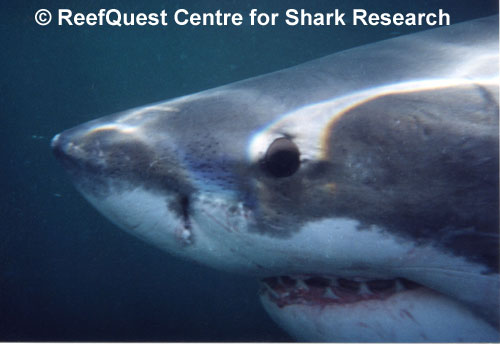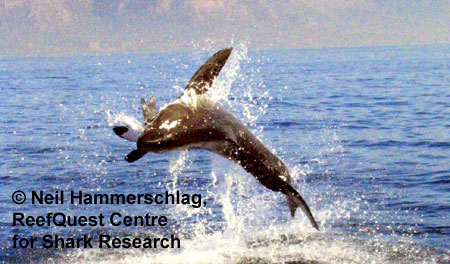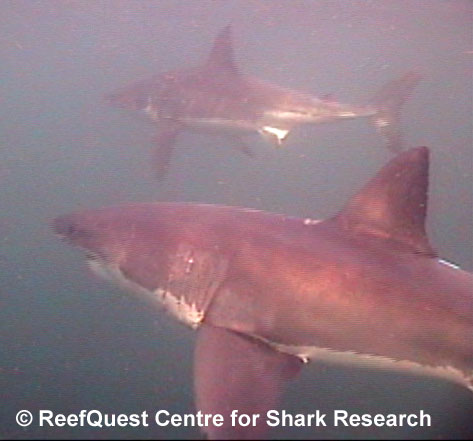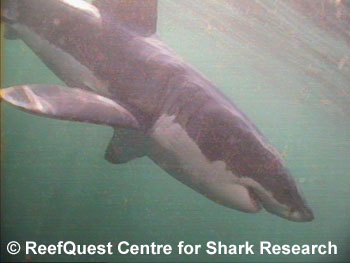Rocky Reefs: Rich Feeding in Cool Waters
White Shark
Of all the creatures that roam the seas, the White Shark (Carcharodon carcharias) is perhaps the best known and least understood. Thanks to countless television documentaries, the face of the ‘Great White’ — with its conical snout, whimsical ‘smile’ sporting large, triangular teeth, and black, inscrutable eyes — is as familiar as that of any human celebrity. And just like any famous person, the day-to-day life of the White Shark is shrouded in mystery, speculation, and myth. This seductive combination of high profile and low visibility fuels our fascination with the White Shark, making it by far the favorite among shark enthusiasts.
Just the Facts:
Size:
Reproduction:
Diet:
Habitat: Sandy Plains, Rocky Reefs, Kelp Forests, Coral Reefs, Deep Sea, Polar Sea Depth: surface to 6150 ft (1875 m) Distribution: Central Pacific, South Pacific, Temperate Eastern Pacific, Tropical Eastern Pacific, Chilean, Western North Atlantic, Caribbean, Argentinean, Eastern North Atlantic/Mediterranean, West African, Southern African, Madagascaran, Arabian, South East Asian, Western Australian, Southeast Australian/New Zealand, Northern Australian, Japanese |
Until recently, we knew next to nothing about the life history of the White Shark. Thanks to numerous recent studies, researchers have started filling in some of the blanks in our knowledge of this much-mythologized animal. We now know many of the basics about White Shark life history, including reproductive mode, gestation period, size at birth, litter size, size and age at maturity for both sexes. But there is still much we do not know about the White Shark.
Maximum size of the White Shark is a subject of intense fascination and controversy, as few things are harder to verify than the length and weight of a giant shark. Although a 23-foot (7-metre) specimen — estimated to have weighed about 7 525 pounds (3 420 kilograms) — from Kangaroo Island, South Australia, is the largest reported in the scientific literature, specimens longer than 20 feet (6 metres) are very, very rare. It should be borne in mind, however, that even a ‘run-of-the-mill’ 15-foot (4.5-metre) White Shark is an enormous animal, about 4.5 feet (1.5 metres) in diameter and weighing a ton (900 kilograms) or more.
Found almost everywhere in the World Ocean but nowhere abundant, the White Shark is as elusive as it is sought after. Although it sometimes ventures into warm and even tropical waters, the White Shark is primarily an inhabitant of cool temperate waters. Such waters are biologically highly productive, nurturing thriving ecosystems that feature an abundance of relatively large animals on which White Sharks can economically feed. In contrast, tropical waters are relatively nutrient poor and marine animals tend to be more diverse but much smaller. It is energetically much more efficient for a predator to gorge itself on a few large meals than to chase down dozens of smaller snacks. White Shark distribution can thus be largely explained in terms of where the waters are sufficiently productive to foster lots of calories packaged in worthwhile dimensions.
Like tunas, billfishes, and several closely related sharks, the White Shark’s circulation is specialized to help it retain body heat. Greatly enlarged blood vessels extending along the White Shark’s flanks shunt blood inward through a special meshwork of tiny blood vessels. These blood vessels interdigitate very closely and carry blood in opposite directions, allowing metabolic heat to be transferred efficiently from the venous to the arterial circulation. With this modified circulatory system, combined with its large and compact body (which has relatively little surface area from which to radiate body heat), White Sharks can greatly slow the rate of heat loss to the surrounding ocean.
|
|
The White Shark is not truly ‘warm-blooded’ nor does it maintain a constant body temperature. The White Shark’s heart and gills operate at environmental temperatures and measurements of its swimming muscles indicate a slow but definite cooling when it moves into cooler water. Despite this ‘thermal lag’, the White Shark is able to maintain its muscle temperature significantly above the ambient — as much as 9 degrees Fahrenheit (5 degrees Celsius) warmer than the surrounding water. Therefore, it is more accurate to describe the White Shark as ‘warm-bodied’.
By being warm-bodied and energetically efficient, the White Shark enjoys many of the benefits of being fully warm-blooded without the concomitant high metabolic cost. Among the many benefits of being warm-bodied are increased muscular endurance and more efficient digestion. But for a predatory fish, the chief benefit of being warm-bodied is that it is able to extend its range into cold, highly productive waters. Thus, the White Shark can exploit food resources — such as preying on fishes and pinnipeds at high latitudes or scavenging whale carcasses at great depths — which cold-blooded coastal sharks cannot.
Each autumn, from late August to early December, White Sharks congregate at the South Farallon Islands, California, apparently to prey upon the seals and sea lions here. Photographs of White Shark dorsal fins, which are as unique as fingerprints, indicate that more than 20 individuals have returned to these Islands at least once and many revisit the Farallons each and every year. At these rocky Islands, White Sharks generally swim within 30 feet (10 metres) of the bottom to depths of about 100 feet (30 metres), but in deeper water tend to stray more from the bottom. Tracking indicates that individual White Sharks patrol discrete areas of these Islands, ranging from about seven-tenths of a square mile (1.8 square kilometres) to 3.5 square miles (9 square kilometres). Intriguingly, the largest White Sharks patrolled the smallest areas and the smallest individuals the largest areas. This may be because older, more experienced White Sharks stake a claim in areas where they have learned hunting tends to be most successful and exclude younger White Sharks from those areas. Younger, less experienced White Sharks thus cruise around the Islands, searching for an unoccupied area where their hunting may or may not prove successful.

White Shark preying upon a young Cape Fur Seal, Seal Island, South Africa
The so-called ‘White’ Shark is typically dark grey to black on its upper surfaces, making its back tough to see from above against the dark rocky substrate. This may help camouflage White Sharks, making them difficult to detect by sharp-eyed seals or sea lions on the surface. This invisibility, in turn, probably allows White Sharks to stalk pinniped prey undetected until close enough to launch a sudden, surprise attack from directly below. Such a strategy maximizes the White Shark’s chances of making a successful kill.
But before a White Shark can capture and consume an individual seal or sea lion, it must first find where these gregarious marine mammals gather. This is where the White Shark’s keen senses come in. The White Shark has enormous olfactory bulbs, among the largest of any shark studied to date. This probably affords the White Shark a particularly keen sense of smell, which may help it locate the tiny, rocky islets seals and sea lions use as haul-out sites by the pungent stench of pinniped excrement. Having located a pinniped colony, a hunting White Shark must single out an individual prey animal. To do that, the White Shark probably relies on its keen eyesight. The White Shark retina has a low rod-to-cone ratio of about 4:1 — roughly the same ratio as in human retinas. Cones are adept at discerning fine details, including color, but require bright light conditions to function. From this, it is believed that White Sharks have acute color vision and rely heavily on eyesight — at least during daylight hours. Recent research at the South Farallon Islands suggests that White Sharks feed at night, too, but we are uncertain which senses they use to detect prey.

White Shark portrait, showing electroreceptive pores,
scent sensitive nostrils, light sensitive eyes and touch sensitive teeth.
A common misconception about White Sharks is that, as they increase in size, their prey type shifts from fishes to marine mammals. A much-publicized study of White Shark predatory behavior seemed to show that individuals smaller than 10 feet (3 metres) feed primarily on bottom fishes while larger individuals shift to feeding on marine mammals, especially pinnipeds. Since young White Sharks have slender teeth well suited to grasping slippery, bite-sized prey and older individuals have broader teeth better suited to sawing hunks from prey too large to be swallowed whole, this dietary shift seemed to make sense.
In truth, what happens is subtler than a wholesale shift from fish to marine mammal prey. Numerous quantitative studies of White Shark diet show clearly that — at every size class — fishes are the predominant prey type. Small White Sharks eat mostly small bottom-dwelling fishes; larger White Sharks eat mostly large fishes, especially rays and other sharks. Marine mammals start appearing in the diet of medium-sized White Sharks simply because — unlike smaller individuals — they possess the dentition and sheer body mass necessary to tackle such large entrées. So White Sharks are predominantly fish-eaters, but larger individuals expand their diet to include marine mammals.
Few aspects of White Shark behavior are as inherently fascinating as predation on marine mammals. Studies reveal that White Shark attacks on Northern Elephant Seals (Mirounga angustirostris) and California Sea Lions (Zalophus californianus) at the South Farallon Islands are chillingly and spellbindingly violent. Most White Shark attacks on these pinnipeds occur near haul-out sites at high tide, when — due to sheer crowding — many of them are forced into the water. Experienced White Sharks thus skulk about the bottom at these sites, looking surfaceward for the silhouette of a swimming seal or sea lion. It then launches a lightening-fast, vertical strike from below — often incapacitating the prey with the initial strike, hurling it completely out of the water.

White Shark breaching on a decoy off the coast of South Africa
Circumstantial evidence suggests that the seasonal appearance of mature female White Sharks at the South Farallon Islands may play a role in this species’ reproduction. Photographic identification of adult White Sharks from the Farallons and off southern California has demonstrated that at least some individuals travel between these two locations. Numerous captures of very young White Sharks in shallow coastal waters off Los Angeles and San Diego — some 600 to 700 miles (960 to 1 100 kilometres) south of the Farallons — suggest that southern California bays may be important pupping grounds for this species. Pregnant White Sharks may therefore use the South Farallon Islands as a sort of ‘truck stop’, preying upon seals and sea lions to stock up on calories for the long migration to pupping grounds off southern California.
That pregnant White Sharks use coastal areas as pupping grounds may be their undoing. In addition to southern California, other important White Shark pupping grounds include the Mid-Atlantic Bight, roughly from New York City to Norfolk, Virginia, and the inner reaches of Spencer Gulf, near the city of Adelaide, South Australia. Los Angeles, San Diego, New York, Norfolk, and Adelaide are all major cities, each home to a million or more people. This uneasy living arrangement brings White Sharks at their youngest and most vulnerable life-stage dangerously close to their most significant predator. Pollution of nursery bays and capture of pregnant White Sharks thus pose significant threats to the continued survival of one of our planet’s most fearsome and fascinating inhabitants.

A pair of White Sharks engaged
in parallel swim, a way for
White Sharks unfamiliar with each other to establish dominance.
Note the lowered pectoral fins on the shark in the background
Known Prey of the White Shark
There is something deeply fascinating about just how many different kinds of creature have been attacked and consumed by the superpredatory White Shark (Carcharodon carcharias). Below is a conservative list, down to lowest identifiable taxon, trolled from the scientific literature as well as unpublished observations by myself and others. Undoubtedly the White Shark has preyed upon many more species than listed here. If the full tally of this euryphagous shark’s prey were available, I wouldn’t be surprised if virtually every moderate- to large-sized animal inhabiting the ocean has — at one time or another — been eaten by the opportunistic White Shark.
Molluscsabalone (Haliotis spp.) snails (Gastropoda) bivalves (Bivalvia) squids (Teuthoidea) cuttlefishes (Sepiodea) CrustaceansDungeness Crab (Cancer magister) Red Rock Crab (Cancer productus) Echinodermssea stars (Asteris sp.) Teleostssturgeons (Acipinceridae) Atlantic Menhaden (Brevortina tyrannus) Pacific Sardine (Sardinops sagax) South African Pilchard (Sardinops ocellata) Pacific Salmon (Oncorhynchus spp.) sea catfishes (Aiidae) searobins (Prionotus sp.) Pacific Hake (Merluccius productus) Silver Hake (Merluccius bilinearis) hakes (Urophycis sp.) lings (Gagidae) flounders and halibuts (Paralichthidae and Pleuronectidae) barracudas (Sphyraenidae) Santer (Cheimerus nufar) Englishman (Chrysoblephus anglicus) Red Tjor-Tjor (Pargellus bellotti natalensis) Hapuku (Polyprion oxygeneios) Bluefish (Pomatomus saltarix) butterfishes (Stromateidae) Striped Bass (Morone saxatilis) White Seabass (Atractoscion nobilis) jacks (Carangidae) Pacific Mackerel (Scomber japonicus) Bluefin Tuna (Thunnus thynnus) Albacore (Thunnus alalunga) Atlantic Bonito (Sarda sarda) Bullet Tuna (Auxis rochei) Frigate Mackerel (Auxis thazard) Broadbill Swordfish (Xiphias gladius) Western Australian Salmon (Arripis truttaceus) Kob (Argyrosomus hololepidotus) rockfishes (Sebastes spp., Sebastodes sp.) Cabezon (Scorpaenichthys marmoratus) Lingcod (Ophiodon elongatus) ChondrichthyansBroadnose Sevengill Shark (Notorynchus cepedianus) Spiny Dogfish (Squalus acanthias) Basking Shark (Cetorhinus maximus)* Sandtiger Shark (Carcharias taurus) Shortfin Mako (Isurus oxyrinchus) Grey Smoothhound Shark (Mustelus californicus) Tope Shark (Galeorhinus galeus) Smooth Dogfish (Mustelus canis) Milk Shark (Rhizoprionodon acutus) Bronze Whaler (Carcharhinus brachyurus) Dusky Shark (Carcharhinus obscurus) Sandbar Shark (Carcharhinus plumbeus) Blue Shark (Prionace glauca) Scalloped Hammerhead (Sphyrna lewini) Lesser Guitarfish (Rhinobatos annulatus) White-Spotted Guitarfish (Rhynchobatus djiddensis) stingrays (Dasyatis spp.) Bat Ray (Myliobatis californicus) Bull Ray (Pteromylaeus bovinus) Spotted Ratfish (Hydrolagus colliei) plownose chimaeras (Callorhynchidae) |
Marine ReptilesLeatherback Sea Turtle (Dermochelys coriacea) Green Sea Turtle (Chelonia mydas) Loggerhead Sea Turtle (Caretta caretta) Sea BirdsJackass Penguin (Spheniscus demersus) penguins (Spheniscidae) Cape Cormorant (Phalacrocorax capensis) gannets (Sula spp.) gulls (Laridae) PinnipedsHarbor Seal (Phoca vitulina) Grey Seal (Halichoerus grypus) Northern Elephant Seal (Mirounga angustrirostris) Australian Sea Lion (Neophoca cinerea) New Zealand Sea Lion (Phocaretos hookeri) California Sea Lion (Zalophus californianus) Northern Fur Seal (Eumetopias jubatus) South American Fur Seal (Arctocephalus australis) Guadalupe Fur Seal (Arctocephalus townsendi) Australian Fur Seal (Arctocephalus pusillus doriferus) Cape Fur Seal (Arctocephalus pusillus pusillus) New Zealand Fur Seal (Arctocephalus forsteri) CetaceansHarbor Porpoise (Phocoena phocoena) Dall’s Porpoise (Phocoenoides dalli) Pacific White-Sided Dolphin (Lagaenorhynchus obliquidens) Dusky Dolphin (Lagaenorhynchus obscurus) Common Dolphin (Delphinus delphis) Bottlenose Dolphin (Tursiops truncatus) Striped Dolphin (Stenella coeruleoalba) Risso’s Dolphin (Grampus griseus) Dwarf Sperm Whale (Kogia simus) Pygmy Sperm Whale (Kogia breviceps) Indo-Pacific Humpbacked Dolphin (Sousa plumbea) Stejneger’s Beaked Whale (Mesoplodon stejnegeri) Cuvier’s Beaked Whale (Ziphius cavirostris) PrimatesHuman (Homo sapiens)
* = possibly taken as carrion |
White Shark Bibliography
More on: Biology of the White Shark
| White Shark Conservation |
Warmbodied Sharks


